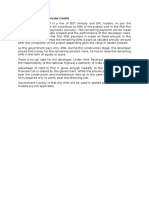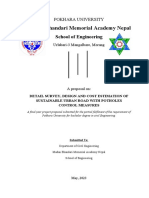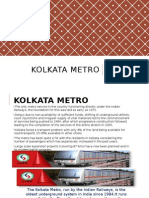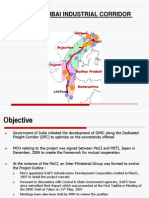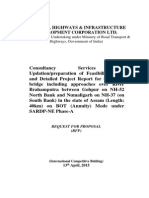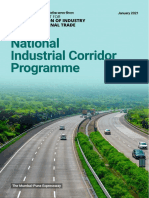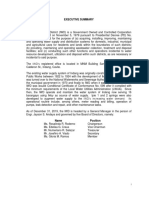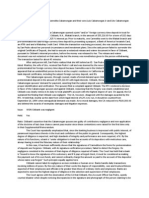Project Report ON Delhi Gurgaon Expressway
Uploaded by
Swati GoyalProject Report ON Delhi Gurgaon Expressway
Uploaded by
Swati GoyalPROJECT REPORT ON DELHI GURGAON EXPRESSWAY
GROUP 3
PROJECT REPORT ON DELHI GURGAON EXPRESSWAY
Group 3 Abhishek Vaish PGP01005 Abhishek verma PGP01006 Arun Marik PGP01014 Bharadwaj Battaram PGP01016 Mohit Salviya PGP01024 Prince Kumar PGP01030 Venkat Bhargav Sreedhara PGP01046
1|P ag e
PROJECT REPORT ON DELHI GURGAON EXPRESSWAY
GROUP 3
Project Description
The National Highways Authority of India (NHAI), under the Ministry of Road Transport & Highways (MoRT&H), was entrusted the responsibility for implementation of the Golden Quadrilateral project (Highway Project connecting the four metro cities of New Delhi, Mumbai, Chennai and Kolkata). As a part of this project, it proposed the conversion of a very busy section of NH-8 connecting Delhi to Gurgaon into a 6/8 lane access controlled divided carriageway. The then existing 4 lane, 27.7 km section of NH-8 between Delhi and Gurgaon with as many as 20 intersections, experienced high vehicular density (145,000 Passenger Car Units (PCUs)/day in 2000) and nonsegregation of traffic that led to increase in accidents, acute congestion, wastage of fuel and excessive pollution. The project was awarded to the consortium of Jaypee Industries and DS Construction Ltd to design, finance, construct, operate & maintain the facility for a concession period of 20 years. As in a typical BOT highway project, the Concessionaire is allowed to collect toll from the users of the project facility during the operation period to recover his investment and the expressway is required to be transferred back to the Government at the end of the concession period. This was the first BOT project in India to have been awarded on negative grant basis where in the concessionaire offered to pay an upfront fee to NHAI in return of the concession as against a capital grant from the Government. In consideration of robust traffic projections, the selected bidder offered to pay Rs. 61.06 crore to NHAI. The expressway was commissioned in January 2008 after much delay primarily owing to issues in land acquisition and changes in the scope of work. It carries more than 180,000 PCUs per day as on date.
2|P ag e
PROJECT REPORT ON DELHI GURGAON EXPRESSWAY
GROUP 3
PPP Structure of the Project
The project was awarded to the consortium of Jaiprakash Industries Ltd and DS Construction Ltd on Built-Operate-Transfer (BOT) basis for a period of 20 years. The selected concessionaire offered to pay Rs. 61.06 crore upfront as negative grant to the NHAI. The Concessionaire was required to design, construct, operate and maintain the expressway in accordance with the specifications as approved by NHAI. The concession period included the construction period to encourage the concessionaire to complete the construction early.
Procurement & Construction (EPC) contract with DS Constructions Limited for this project Key Obligations of NHAI NHAI was responsible for undertaking land acquisition and providing the Right of Way (RoW) to the Concessionaire free from all encumbrances. A notional concession fee of Re.1/- was to be paid annually by the Concessionaire to NHAI.During the development period, NHAI undertook the operation and maintenance of the existing
Jaiprakash Industries Ltd DS Construction Ltd
Delhi Gurgaon Super Connectivity Ltd
A Special Purpose Vehicle called the Delhi Gurgaon Super Connectivity Ltd (formerly Jaypee DSC Ventures Ltd.), was created for execution of the project. While at the time of bidding, Jaiprakash Industries had a controlling stake of 51% and DS Constructions held 49%, during the course of project implementation, Jaiprakash Industries reduced its stake in the SPV to about 1.2% The SPV entered into a fixed time-fixed price Engineering,
highway at its own cost.The shifting ofutilities and related expenses was the responsibility of NHAI. NHAI was also required to have necessary environmental clearances, permits etc. granted to the Concessionaire. A loan facility, in case of the revenue falling short of subsistence revenue level, was made available by NHAI
3|P ag e
PROJECT REPORT ON DELHI GURGAON EXPRESSWAY
GROUP 3
at the State Bank of India Prime Lending Rate. Such a loan could also be provided by NHAI to cover a shortfall in meeting debt service payments. Key Obligations of the Concessionaire The Concessionaire was required to comply with the all the requirements needed for clearances, approvals, permits etc. from various government agencies. The Concessionaire was obliged to enter into a state support agreement with NHAI, the Government of National Capital Territory of Delhi (GoNCTD) and Government of
Haryana (GoH). A performance security was to be paid by the Concessionaire on or before the date of the Agreement for its due and faithful obligation during the Construction Period. To allow recovery of investment and to earn a suitable return, the Concessionaire is entitled to collect toll from the users of the expressway during the operation period. The toll is notified by the MoRTH and there is an annual revision linked to the extent of variation in the WPI. The toll has to be shared with NHAI if more than 130,000 PCUs are tolled on the expressway.
Financing Information FINANCING STRUCTURE
financial closure (9 May 2003) is provided in the above figure. Rs. 200 crore of the debt was provided by the Housing and Urban Development Corporation Limited (HUDCO). The other lenders included State Bank of Mysore (Rs. 30 crore), Punjab National Bank (Rs. 30 crore), Srei International Finance (Rs. 25 crore) and Jammu & Kashmir Bank (Rs. 15 crore). The SPV also issued non convertible debentures amounting to Rs. 50 crore to LIC and Rs. 37.30 crore to UTI Bank. The actual cost of the project was eventually Rs. 1,175 crore. The project cost overrun was funded by the promoters, by withholding payments to DSC Limited (EPC contractor) and from the amount received from NHAI (Rs. 155.25 crore) on account of changes in scope.
164.2
DEBT 383.3 EQUITY
Figure 1(in cr)
The funding for the project at the time of
4|P ag e
PROJECT REPORT ON DELHI GURGAON EXPRESSWAY
GROUP 3
Process Analysis
Inception The plan for an expressway connecting Gurgaon and Delhi was initiated in the late 1990s and a detailed project report was prepared for the same. Subsequently, in 2000-01, the MoRT&H decided to augment the capacity of the National Highways connecting the four metros under the prestigious Golden Quadrilateral project, as traffic intensity on these corridors had increased manifold which hampered safe and efficient movement of vehicles. As per the capacity augmentation plan, the Western Transport Corridor comprising the National Highway (NH) 8 (Delhi-Jaipur-AhmedabadMumbai) was identified as one of the top priorities to be undertaken for upgradation. NH-8 carries a sizeable amount of intra-state and inter-state traffic as well as importexport traffic to and from the ports on the Arabian Sea. Accordingly, NHAI decided to upgrade the section of NH-8 connecting Delhi and Gurgaon into 8/6 lane access controlled expressway as it was the busiest part of the highway. It was estimated that the expressway would reduce the travel time between the Delhi and Gurgaon from about 65 minutes to around 20 minutes. NHAI was finding itself constrained to fund the estimated Rs. 555 Crore for the expressway. The risk of cost escalation during the period of construction was also a cause for concern. Malaysia's Construction Industry Development Board (CIDB) was initially proposed to take up this project under the memorandum of understanding (MoU) route as a part of a government to government initiative. However, this proposal sought a grant of Rs. 120 crore from NHAI and was thus rejected. The Government of India, at the time, was keen to promote public private partnership (PPP) in viable expressway projects to attract funding and capitalize on private sector efficiency. It was therefore decided to undertake the project on BOT (Build-operate-Transfer) basis. NHAI used the Detailed Project Report prepared in 1998 for the traffic projections for this project. Procurement The MoRT&H invited pre-qualification bids in 2001. The project was initially envisaged to require a capital grant to be paid by NHAI to the successful bidder towards the cost of construction for enhancing the viability of the highway project. However, considering the robust traffic projections, bids were received with negative grants. In April 2002, the consortium of Jaiprakash Industries and DS Constructions was declared the successful bidder. RBM Malaysia, which was the L2 bidder, had quoted Rs 55 crore as the negative grant. Other bidders were Gamuda Malaysia, IJM Malaysia and Larsen & Toubro (L&T). Development The erstwhile Jaypee DSC Ventures Ltd. (now known as Delhi Gurgaon Super Connectivity Ltd.), the SPV incorporated by the Concessionaire for the project, achieved financial closure in May 2003. The construction of the expressway commenced in January 2003.
5|P ag e
PROJECT REPORT ON DELHI GURGAON EXPRESSWAY
GROUP 3
In June 2004, Jaiprakash Industries, despite being the lead promoter, sold its stake to DS Constructions and retained only 1.2%.The project development, however, soon ran into issues over approvals, land acquisition and additions to the scope of work which was largely due to the physical setting of the project highway. The highway was the first semi-access controlled highway in an urban environment traversing two states besides having access to both the domestic and the international airport and sensitive defence establishments along its route. There were more than 15 government agencies/civic bodies such as the Delhi Jal Board, the Ministry of Defence, GAIL, BPCL, Delhi Development Authority (DDA), Haryana Urban Development Authority (HUDA), GoH, GoNCTD, Haryana Tourism, Airports Authority of India (AAI), etc., affected by the development of this highway that had to grant various approvals for the project. This became a complex and time consuming process during the construction period. Being in a thickly populated environment, land acquisition became a problem impacting delivery. This was in fact one of the core obligations of NHAI and the State Government under the tripartite State Support Agreement entered into with the concessionaire. NHAI and other agencies involved with this project put in a great deal of effort to hasten the process. However, there were certain small parcels of land which were difficult to acquire. In addition, court cases, removal of trees, shifting of religious structures and the massive number of utilities that had to be shifted contributed to the delay.
Another major reason for delay in project completion was the change in the scope of work. There were substantial changes in the original design that were sought by NHAI and the government keeping in mind future requirements and the convenience of commuters. Out of a total of 11 structures, spread over the entire project length, 9 structures had significant design modifications. Since the structures were closely spaced, the entire alignment of the project was affected which necessitated the change of scope and the scheduled project completion date had to be revised. Demands made by bodies like HUDA and DDA regarding other connected projects also played a role in the delay. The provisional change of scope order was finalised and issued to the concessionaire in July 2005 just days before the original scheduled completion date. Moreover, with the high density of traffic on the route and the requirement of a minimum length for acceleration and de-acceleration of traffic being approximately 300 meters (As per the Indian Roads Congress Provisions), the partial opening of expressway had to be held back for safety reasons even if completed at certain locations. Delivery The project was commissioned on 25 January, 2008. The expressway is fully operational and is handling a significant traffic volume of more than 180,000 PCUs per day, growing at 9% year-on-year. Exit The concession period is for 20 years and the projected end date is 11 January 2023 when the expressway will be handed over to the government.
6|P ag e
PROJECT REPORT ON DELHI GURGAON EXPRESSWAY
GROUP 3
RISK ANALYSIS
PRE-OPERATIVE RISKS
Risk Type Sensitivity Risk Period Primary Risk Bearer Comments
NHAI was liable to pay damages of if it failed to provide RoW within the specified time. Delays in land acquisition resulted in an increase in the acquisition cost for the government. They also resulted in loss of potential revenue accruing to the Concessionaire due to delays in commencement of operations.
Delays in land acquisition
High
0-5 years
NHAI
Financing risks
Medium
0-5 years
Private sector
The Concessionaire was required to achieve financial closure within 180 days from the date of the agreement beyond which an additional period of 90 days was allowed subject to an advance weekly payment of Rs. 1,00,000 per week as damages by the Concessionaire for delay in achieving financial closure.
Approvals
Low
0-5 years
Private sector
With multiple stake holders involved such as GoH, GoNCTD, DDA, HUDA, Ministry of Defence, AAI, etc., the process of approvals was slow.
CONSTRUCTION PHASE RISKS
Risk Type
Design Risk
Sensitivity
High
Risk Period
0-5 years
Primary Risk Bearer
Private sector
Comments
There were substantial changes in the design that led to escalation in cost as well as time over-run. This meant revenue loss to the Concessionaire as the concession period was not altered. If Concessionaire failed to complete the project construction by the scheduled completion date, the agreement prescribed weekly damages at the rate of 0.01% of the total project cost.The construction of the expressway got delayed due to inordinate delays in land acquisition and changes in the scope of work. The risk was primarily borne by the Concessionaire and more specifically by DS Constructions Ltd. as it was also the EPC contractor for the project. For change in scope, NHAI was also asked to contribute the increased investment requirement.
Construction Risk
High
0-5 years
Private sector
7|P ag e
PROJECT REPORT ON DELHI GURGAON EXPRESSWAY
GROUP 3
OPERATIONS PHASE RISK
Risk Type
Operations & Maintenance Risk
Sensitivity
Medium
Risk Period Primary Risk Bearer
Throughout Private sector
Comments
The risk is primarily with the concessionaire.NHAI as the concession authority has set stringent performance standards and obligations to be met. Market risk that primarily manifests in terms of lack of tollable traffic in a typical BOT project is with the private sector.However, it has proven to be non-existent in the particular case. The actual traffic has so far been much higher than that projected and is only expected to grow. The only risk factor could be that of the possibility of a competing road facility allowed to be constructed by NHAI, GoNCTD or GoH either on the PCU level reaching 170,000/day (continuous for 180 days) or expiry of 20 years, whichever is earlier. However, this risk is also sufficiently mitigated through the allowance of an increase in the concession period (equal to half the number of years by which commissioning of such competing road precedes expiry of Concession period) and the provision of toll for the competing facility to be kept higher (133% of per km fee) than that applicable for the expressway. These are a result of adverse movements in interest rates, exchange rates, etc. and the private sector is expected to manage them through appropriate financial management techniques.
Market Risk
Low
Throughout
Private sector
Financial Risks
Medium
Throughout
Private sector
OTHER RISKS
Risk Type Sensitivity Risk Period Primary Risk Bearer Comments
In case a change in law results in a financial burden greater than Rs. 1 crore in any accounting year for the concessionaire, the concessionaire may notify NHAI and propose amendments to the concession agreement Private sector and so that the concessionaire is in the same financial position.Similarly, if a NHAI change in law results in a financial benefit greater than Rs. 1 crore for the concessionaire, NHAI may notify and propose changes in the concession agreement. In case of a Force Majeure event before financial closure, the date for achieving financial closure shall be extended by the period for which the force majeure event shall subsist.In case of a Force Majeure event after financial closure, before commencement of operations, the dates in the NHAI project completion schedule and the concession period shall be extended. In case of a Force Majeure event after commencement of operations, the concessionaire shall make efforts to collect toll, failing which the concession period shall be extended.
Change in Law
Low
Throughout
Force Majeure
Low
Throughout
8|P ag e
PROJECT REPORT ON DELHI GURGAON EXPRESSWAY
GROUP 3
HANDOVER RISKS EVENT
Risk Type Sensitivity Risk Period Primary Risk Bearer Comments
The risk of poor condition of assets on transfer is with the private operator.As per the agreement, a joint inspection shall be conducted, not less than 30 months or more than 36 months prior to the expiry of the concession period. 2 years prior to the expiry, an amount equivalent to the fees realised for a traffic volume of 10,000 PCUs/day for the last 2 years or higher based on certification from the Independent Consultant shall be retained in an escrow account for renewal works. For a Concessionaire event of default, NHAI will pay a termination payment equal to 90% of the debt due less any insurance claims. For an NHAI event of default during operations period, NHAI will pay a termination payment equal to the total debt due, 120% of subordinated debt, 150% of the equity subscribed in cash and the negative grant amount. Beyond 3 years from appointed date, the equity amount will be adjusted for changes in the Wholesale Price Index and this adjusted amount will be reduced by 7.5% every year.
Handover risk
Medium
Last 2.5 to 3 years
Private sector
Concessionaire event of default
Medium
Throughout
Private sector
NHAIs event of default
Low
Throughout
NHAI
9|P ag e
You might also like
- New Town Development Delhi Mumbai KolkattaNo ratings yetNew Town Development Delhi Mumbai Kolkatta40 pages
- Home Seller's RE Sales Contract Filled-In Example PDF93% (15)Home Seller's RE Sales Contract Filled-In Example PDF3 pages
- Public Private Partnership: Vadodara-Halol Toll Road: Case Study 07 November 2013No ratings yetPublic Private Partnership: Vadodara-Halol Toll Road: Case Study 07 November 20132 pages
- Pendium PPP Project in Infrastructure PDFNo ratings yetPendium PPP Project in Infrastructure PDF122 pages
- Feasibility Study Report of Bangluru-Chennai Expressway100% (1)Feasibility Study Report of Bangluru-Chennai Expressway54 pages
- Kolkata Metro: Submitted By:-Azhar Ayyub Ashish Pandey Saurav Juyal Siddharth PathakNo ratings yetKolkata Metro: Submitted By:-Azhar Ayyub Ashish Pandey Saurav Juyal Siddharth Pathak19 pages
- Case Study - PPP in Del-Gurgaon ExpresswayNo ratings yetCase Study - PPP in Del-Gurgaon Expressway12 pages
- Executive Summary Etawah - Chakeri PDF (07!07!2011)No ratings yetExecutive Summary Etawah - Chakeri PDF (07!07!2011)14 pages
- Lucknow-Agra Expressway Project Management (Srishti Mishra)No ratings yetLucknow-Agra Expressway Project Management (Srishti Mishra)12 pages
- The Kaushalya Dam Being Constructed On Ghaggar River in Panchkula at A Cost of Rs 217 Crore Will Soon Be Made FunctionalNo ratings yetThe Kaushalya Dam Being Constructed On Ghaggar River in Panchkula at A Cost of Rs 217 Crore Will Soon Be Made Functional3 pages
- Project Finance - Case Synopsis: Gangavaram Port LTDNo ratings yetProject Finance - Case Synopsis: Gangavaram Port LTD9 pages
- Current Status & Future of The Oman-GCC Railway - Abdulrahman Al Hatmi - MOTCNo ratings yetCurrent Status & Future of The Oman-GCC Railway - Abdulrahman Al Hatmi - MOTC20 pages
- Key Development Public Private Partnership Projects at Mumbai: Selected Case StudiesNo ratings yetKey Development Public Private Partnership Projects at Mumbai: Selected Case Studies5 pages
- Group 7 - Mumhdsakjbai Monorail - Project Management Report100% (1)Group 7 - Mumhdsakjbai Monorail - Project Management Report21 pages
- Planning and Surveying The New Capital City of Andhra Pradesh - Amaravati - MR See Seng GuanNo ratings yetPlanning and Surveying The New Capital City of Andhra Pradesh - Amaravati - MR See Seng Guan83 pages
- NationalIndustrialCorridor Programme 11june2021100% (1)NationalIndustrialCorridor Programme 11june20219 pages
- GT Road Expressway KSK - Feasibility ReportNo ratings yetGT Road Expressway KSK - Feasibility Report53 pages
- Indang Water District Cavite Executive Summary 2016 2019No ratings yetIndang Water District Cavite Executive Summary 2016 201910 pages
- Households - The Influences On Spending, Saving and BorrowingNo ratings yetHouseholds - The Influences On Spending, Saving and Borrowing17 pages
- Submitted in Partial Fulfilment of The Requirements For The Award of The Degree ofNo ratings yetSubmitted in Partial Fulfilment of The Requirements For The Award of The Degree of88 pages
- Trainity Data Analytics Training Project 6No ratings yetTrainity Data Analytics Training Project 622 pages
- Project Reports On Non Performing Assets NPAs in Banking Industry67% (6)Project Reports On Non Performing Assets NPAs in Banking Industry72 pages
- Capital Structure: Solutions To Assignment ProblemsNo ratings yetCapital Structure: Solutions To Assignment Problems8 pages
- Cash Flow Statement: Comparative Analysis of Financing, Operating and Investing ActivitiesNo ratings yetCash Flow Statement: Comparative Analysis of Financing, Operating and Investing Activities5 pages
- Agreement Between Irving Picard and Madoff Family MembersNo ratings yetAgreement Between Irving Picard and Madoff Family Members8 pages
- Master in Business Administration Mba 308 - Financial ManagementNo ratings yetMaster in Business Administration Mba 308 - Financial Management5 pages
- Home Seller's RE Sales Contract Filled-In Example PDFHome Seller's RE Sales Contract Filled-In Example PDF
- Public Private Partnership: Vadodara-Halol Toll Road: Case Study 07 November 2013Public Private Partnership: Vadodara-Halol Toll Road: Case Study 07 November 2013
- Feasibility Study Report of Bangluru-Chennai ExpresswayFeasibility Study Report of Bangluru-Chennai Expressway
- Kolkata Metro: Submitted By:-Azhar Ayyub Ashish Pandey Saurav Juyal Siddharth PathakKolkata Metro: Submitted By:-Azhar Ayyub Ashish Pandey Saurav Juyal Siddharth Pathak
- Executive Summary Etawah - Chakeri PDF (07!07!2011)Executive Summary Etawah - Chakeri PDF (07!07!2011)
- Lucknow-Agra Expressway Project Management (Srishti Mishra)Lucknow-Agra Expressway Project Management (Srishti Mishra)
- The Kaushalya Dam Being Constructed On Ghaggar River in Panchkula at A Cost of Rs 217 Crore Will Soon Be Made FunctionalThe Kaushalya Dam Being Constructed On Ghaggar River in Panchkula at A Cost of Rs 217 Crore Will Soon Be Made Functional
- Project Finance - Case Synopsis: Gangavaram Port LTDProject Finance - Case Synopsis: Gangavaram Port LTD
- Current Status & Future of The Oman-GCC Railway - Abdulrahman Al Hatmi - MOTCCurrent Status & Future of The Oman-GCC Railway - Abdulrahman Al Hatmi - MOTC
- Key Development Public Private Partnership Projects at Mumbai: Selected Case StudiesKey Development Public Private Partnership Projects at Mumbai: Selected Case Studies
- Group 7 - Mumhdsakjbai Monorail - Project Management ReportGroup 7 - Mumhdsakjbai Monorail - Project Management Report
- Planning and Surveying The New Capital City of Andhra Pradesh - Amaravati - MR See Seng GuanPlanning and Surveying The New Capital City of Andhra Pradesh - Amaravati - MR See Seng Guan
- Indang Water District Cavite Executive Summary 2016 2019Indang Water District Cavite Executive Summary 2016 2019
- Households - The Influences On Spending, Saving and BorrowingHouseholds - The Influences On Spending, Saving and Borrowing
- Submitted in Partial Fulfilment of The Requirements For The Award of The Degree ofSubmitted in Partial Fulfilment of The Requirements For The Award of The Degree of
- Project Reports On Non Performing Assets NPAs in Banking IndustryProject Reports On Non Performing Assets NPAs in Banking Industry
- Capital Structure: Solutions To Assignment ProblemsCapital Structure: Solutions To Assignment Problems
- Cash Flow Statement: Comparative Analysis of Financing, Operating and Investing ActivitiesCash Flow Statement: Comparative Analysis of Financing, Operating and Investing Activities
- Agreement Between Irving Picard and Madoff Family MembersAgreement Between Irving Picard and Madoff Family Members
- Master in Business Administration Mba 308 - Financial ManagementMaster in Business Administration Mba 308 - Financial Management






